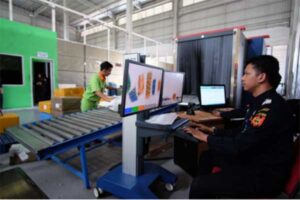
Second or foreign language teaching consists of any activity on the part of one person intended to facilitate the learning by another person of a language which is not his or her native one.
The term facilitate clearly implies that teaching orientation now must be transaction model for some reason that transferring knowledge from teacher to students nowadays has been regarded rather out of date as well as inflexible there by being less democratic viewed from the point of view of students or learning participants.
Teaching English sounds to the Indonesian students poses a lot of problems, one of which is the constant interference of the native language systems of the students on that of the target language. However, the motto “As A teacher, I am unique and powerful” is one of the answers that deserves to be credited.
Howard B. Altman of University of Louisville (1981) set an eighty five skills of second language teachers, one of which is becoming a master of error analysis, another is a master of pronunciation technique. This paper deals with these two problems which are so ubiquitous in my country, Indonesia.
The Teaching of Problematic English Sounds to the Indonesian Beginners Through Contrastive Analysis on Distinctive phonological Features
Contrastive analysis in the phonological features is predicted to assist the Indonesian learners, particularly the beginners. This is the method of linguistic analysis which shows the similarities and differences between two or more language or dialects with the aim of finding principles which can be applied to practical problems in language teaching and translation, with special emphasis on transfer, interference and equivalents. (Hartmann & F.C. Stork 1973:53)
Mastering English sounds and the Indonesian ones is crucial so long as the goal of second or foreign language teaching is to achieve the teacher’s and students communicative competence. It is for this reason paulston and Bruder (1976:55-56) comments: “Generally communicative competence is taken to be the objective of language teaching: the production of speakers competent to communicate in the target language.”
Communicative competence must include not only the linguistic forms of a language but also a knowledge of when, how and to whom it is appropriate to use these forms (Dell Hymes in Paulston & bruder 1976:57).
The term competence has been referred to by N. Chomsky as “the ability all native speakers have of being able to understand and produce sentences which they have never heard before; it refers in this sense to the code which underlies all utterances in a given language.” (Chomsky in Hartmann and Stork 1973:44).
The competence here in this paper, however, is confined to the phonological features of both English and Indonesian which the writer engaged along with Professor Kenneth Miner of the Linguistic Department of Kansas University, Lawrence Kansas, USA. He took three semesters attending the Phonology class during his study here.
Phonology, which is one of the biggest elements of language, is the science of speech sounds and sound patterns. Phonological features of the source language and those of the target language should be thoroughtly mastered by teachers and students if they wish to be called “near native accent” in the language sound mastery. This article is just highlight of the distinctive features of both English and Indonesian to assist those being involved in the teaching of English and Indonesian in this country, Indonesia
An English teacher must be competent in the subject matter he teaches and be pedagogic in transferring this content to his students. To be competent in his subject, a teacher must do his best to improve the science of the target language and that of the students native language. In other words, he should study a great deal about language. In a linguistics or English department a teacher also should focus on the ways of teaching or methods that will enable him to easily motivate his students to become involved in teaching and learning processes. In other words, a language teacher has to spend some time in studying “process” as well as “content”.
Teachers with a basic knowledge of linguistics will be able to conduct a contractive analysis to help them focus on the differences between aspects of the two languages. This will allow them to achieve their objectives without wasting much time. The knowledge of pedagogy, on the other hand, gives the teachers insight about how to facilitate the classroom techniques to make their teaching more effective and interesting to the students. It is realized that, particularly for young students, there will not be any good learning process unless the materials and teaching techniques are attractive and appropriate for them.
Conclusions and Recommendations of Problematic English Sounds
Teaching problematic English sound segements to Indonesian beginners is difficult because, in addition to learning more languages simultaneously, English is regarded as a foreign language (L3) rather than as a second language (L2) for them; therefore, it is harder to teach English to Indonesian beginners than to Spanish or Arabic beginners.
Another major problem of teaching English sounds is that there are many regional English accents and dialects spoken throughout the United States and Britain, not to mention Australia and New Zealand or other English-speaking countries. The English being taught so far to Indonesian beginners, however, is, in general, British English. The writer’s next assignment is to introduce American English along with other major dialects of English.
The powerful aspect of phonological study that enables the language teachers to have an accurate description of the language sound systems is the study of distinctive features. This study needs to be developed and introduced to prospective English teachers as a new study of language.
The following are recommendations for English teachers as well as those who are concerned with teaching English in Indonesia:
- An English teacher should always try to improve his knowledge of both his subject matter and teaching methodology so as to become a good model as well as an expert in his teaching area.
- An English teacher together with linguists should carry out an analysis in terms of phonology, especially on the basis of features in order that they can easily identify which sounds are easy for students and which ones are difficult and need additional attention.
- An English teacher teaching sounds should give a good model to his students in a very simple way. When he is teaching the aspirated /p/. for example, the teacher can demonstrate the proper quality of that sound by holding a piece of paper at his mouth and than pronounce some words containing the /p/. He does not have to get them to learn English with familiar sounds in terms of features. It is not effective to introduce to the students that the English sound /p/ is “plus heightened subglottal pressure.”
- An English teacher should read books on various techniques of language teaching, but it is also the government’s responsibility always to introduce books currently, used in the international language forum so hat the teachers can benefit from them.
Problematic English Sounds to the Indonesian Beginners – Temporaktif Education






